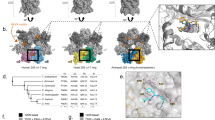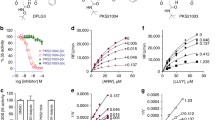We studied the effect of β1i-specific peptidyl aldehyde IPSI-001 on proteasome from mammalian cells. In concentrations <1 μM, this agent effectively suppressed immunoproteasome, but only slightly reduced chymotrypsin-like activity of constitutive proteasome. Intraperitoneal administration of this inhibitor to C3H/He mice in a dose of 100 mg/kg induced no significant physiological or behavioral changes, which attested to its considerable therapeutic potential in the treatment of autoimmune neurodegenerative pathologies.
Similar content being viewed by others
References
M. Basler, S. Mundt, T. Muchamuel, C. Moll, J. Jiang, M. Groettrup, and C. J. Kirk, Inhibition of the immunoproteasome ameliorates experimental autoimmuneencephalomyelitis. EMBO Mol. Med., 6, No. 2, 226-238 (2014).
A. Belogurov Jr, A. Kudriaeva, E. Kuzina, I. Smirnov, T. Bobik, N. Ponomarenko, Y. Kravtsova-Ivantsiv, A. Ciechanover, and A. Gabibov, Multiple sclerosis autoantigen myelin basic protein escapes control by ubiquitinationduring proteasomal degradation. J. Biol. Chem., 289, No. 25, 17,758-17,766 (2014).
A. Belogurov Jr, E. Kuzina, A. Kudriaeva, A. Kononikhin, S. Kovalchuk, Y. Surina, I. Smirnov, Y. Lomakin, A. Bacheva, A. Stepanov, Y. Karpova, Y. Lyupina, O. Kharybin, D. Melamed, N. Ponomarenko, N. Sharova, E. Nikolaev, and A. Gabibov, Ubiquitin-independent proteosomal degradation of myelin basic protein contributes todevelopment of neurodegenerative autoimmunity. FASEB J., 29, No. 5, 1901-1913 (2015).
J. Chapiro, S. Claverol, F. Piette, W. Ma, V. Stroobant, B. Guillaume, J. E. Gairin, S. Morel, O. Burlet-Schiltz, B. Monsarrat, T. Boon, and B. J. Van den Eynde, Destructive cleavage of antigenic peptides either by the immunoproteasome or by thestandard proteasome results in differential antigen presentation. J. Immunol., 176, No. 2, 1053-1061 (2006).
W. Chen, C. C. Norbury, Y. Cho, J. W. Yewdell, and J. R. Bennink, Immunoproteasomes shape immunodominance hierarchies of antiviral CD8(+) T cells at the levels of T cell repertoire and presentation of viral antigens. J. Exp. Med., 193, No. 11, 1319-1326 (2001).
N. Fissolo, M. Kraus, M. Reich, M. Ayturan, H. Overkleeft, C. Driessen, and R. Weissert, Dual inhibition of proteasomal and lysosomal proteolysis ameliorates autoimmunecentral nervous system inflammation. Eur. J. Immunol., 38, No. 9, 2401-2411 (2008).
M. H. Glickman and A. Ciechanover, The ubiquitin-proteasome proteolytic pathway: destruction for the sake ofconstruction. Physiol. Rev., 82, No. 2, 373-428 (2008).
D. J. Kuhn, S. A. Hunsucker, Q. Chen, P. M. Voorhees, M. Orlowski, and R. Z. Orlowski, Targeted inhibition of the immunoproteasome is a potent strategy against models of multiple myeloma that overcomes resistance to conventional drugs and nonspecific proteasome inhibitors. Blood, 113, No. 19, 4667-4676 (2009).
E. S. Kuzina, E. L. Chernolovskaya, A. A. Kudriaeva, M. A. Zenkova, V. D Knorre., E. A. Surina, N. A. Ponomarenko, T. V Bobik., I. V. Smirnov, A. V Bacheva., A. A. Belogurov, A. G. Gabibov, and V. V. Vlasov, Immunoproteasome enhances intracellular proteolysis of myelin basic protein. Dokl. Biochem. Biophys., 453, 300-303 (2010).
Z. Miller, L. Ao, K. B. Kim, and W. Lee, Inhibitors of the immunoproteasome: current status and future directions. Curr. Pharm. Des., 19, No. 22, 4140-4151 (2013).
M. Raule, F. Cerruti, N. Benaroudj, R. Migotti, J. Kikuchi, A. Bachi, A. Navon, G. Dittmar, and P. Cascio, PA28ab reduces size and increases hydrophilicity of 20S immunoproteasome peptideproducts. Chem. Biol., 21, No. 4, 470-480 (2014).
K. L. Rock, C. Gramm, L. Rothstein, K. Clark, R. Stein, L. Dick, D. Hwang, and A. L. Goldberg, Inhibitors of the proteasome block the degradation of most cell proteins and thegeneration of peptides presented on MHC class I molecules. Cell, 78, No. 5, 761-771 (1994).
E. J. Sijts and P. M. Kloetzel, The role of the proteasome in the generation of MHC class I ligands and immuneresponses. Cell. Mol. Life Sci., 68, No. 9, 1491-1502 (2011).
C. L. Vanderlugt, S. M. Rahbe, P. J. Elliott, M. C. Dal Canto, S. D. Miller, Treatment of established relapsing experimental autoimmune encephalomyelitis with the proteasome inhibitor PS-519. J. Autoimmun., 14, No. 3, 205-211 (2000).
Author information
Authors and Affiliations
Corresponding author
Additional information
Translated from Byulleten’ Eksperimental’noi Biologii i Meditsiny, Vol. 161, No. 1, pp. 80-83, January, 2016
Rights and permissions
About this article
Cite this article
Kuzina, E.S., Kudriaeva, A.A., Maltseva, D.V. et al. Peptidyl Aldehyde Specifically Interacts with Immunosubunit β1i Proteasome: In Vitro and In Vivo Effects. Bull Exp Biol Med 161, 69–71 (2016). https://doi.org/10.1007/s10517-016-3347-9
Received:
Published:
Issue Date:
DOI: https://doi.org/10.1007/s10517-016-3347-9




